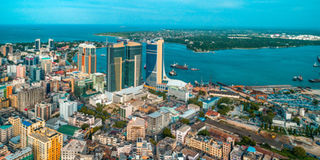Why private sector should take lead for Dar’s future

Dar es Salaam city is suffering from increased hazards to properties, businesses, while heat and water shortages affect people’s health and livelihoods. PHOTO|FILE
What you need to know:
- Skilled professionals from the private sector including land owners, developers, engineering and architectural firms are a cornerstone to transforming the city
By Mbazi Marisa
Dar es Salaam. The city of Dar es Salaam is proliferating with a population of more than seven million and is currently Africa’s sixth largest city, according to the United Nations.
The city’s population is expected to sprout to over 10 million by 2030 to attain the megacity status.
This prosperity has positioned local businesses, attracted significant foreign investments and aggrandised the development of large infrastructures.
On the other hand, Dar es Salaam has been spotted to strive to have reliable public services, incredible multicultural activities and employment opportunities.
However, the way Dar es Salaam is growing has depleted its urban green spaces resulting in unexpected environmental challenges.
Green spaces have historically allowed Dar es Salaam rivers to accommodate the severe downpours during the rainy season, providing a cooling effect during the hot season and recharging the water wells used in the city.
The growth of areas covered by concrete, increasing population and businesses established in areas that were once covered by forests and riverbeds have led to increased flooding, temperatures in the urban centre and water wells that are depleted and infiltrated by seawater.
The city is suffering from increased hazards to properties, businesses, while heat and water shortages affect people’s health and livelihoods.
Additionally, it is making the city less livable and attractive for new businesses.
Looking forward to the future, with more urban growth and evolving rainfall and temperature patterns due to climate change, the Government of Tanzania through the President’s Office Regional Administration and Local Government (PO-RALG) is collaborating with various stakeholders in exploring the Green Dar initiative.
Other partners are the World Bank (WB), the Nordic Development Fund (NDF), the Tanzania Urban Resilience Programme, the Government of Japan, the UK Aid, Tokyo Development Learning Centre and Quality Infrastructure Investment Partnership.
“The public sector plays an important role in driving this agenda both in terms of roads construction, public spaces and drainage with greening and sustainable drainage and policies approval,” says the WB senior urban specialist, Mr John Morton.
According to him, champions and skilled professionals from the private sector including land owners, developers, engineering and architectural firms are a cornerstone to transforming Dar es Salaam into a resilient and livable city through greening and green infrastructure.
Therefore, the private sectors are increasingly encouraged to help leverage opportunities that will mitigate challenges of rapid urbanisation, by playing a role in urban governance and influencing urban areas to develop in inclusive and sustainable ways.
But, the big burning question is how can we invite the private sectors to convert to unlock the financial and human resources to mobilise dynamic actions?, asks Kijani Pamoja executive director Sarah Scott.

According to experts, re-greening the city will give it a competitive advantage to attract foreign investments. PHOTO|FILE
She says her organisation promotes an opportunity for the Tanzanian government to steer the coordination of the private sectors by setting a table for investment and financial enablers of the urban economy like banks, large corporations and Small and Medium Entrepreneurs (SMEs) to become top players in greening Dar es Salaam, Zanzibar and other fast-growing cities.
“Kijani Pamoja movement is a Pan-Africa youth-led movement that aims to inspire African governments, public and private corporations and communities to come together to re-green some of the fast-growing cities in Africa,” says Ms Scott.
She stresses that the private sector can improve research, facts, findings and more importantly the use of mobilisation of human and financial resources that will help to mobilise the communities to green cities.
“We need collective action, implementation, tools, partnerships and resources (human and financial), cities and inhabitants mobilisation in order to make Dar es Salaam, the greenest city in the continent,” she says.
According to her, the country needs financial resources and capacity building in developing strategies and engagement plans.
Furthermore, she says the project should be connected with finance, noting that the investment project includes project and line-up donors.
“Influencing the work packages without book stopping the finance. We can’t look at this as a programme, bookmarked by a start and finish date. It needs to be ongoing and have 10-50 years plans,” she says.
She says nonetheless that combining the motivation of growing a green livable city with creating green job opportunities for urban youth and the creation of dynamic partnerships for both the government, private and public sectors.
“If the greening plan works, Dar es Salaam has a competitive edge to attract foreign companies that would in turn create more job opportunities for the urban youth and increase economic productivity,” she says.


